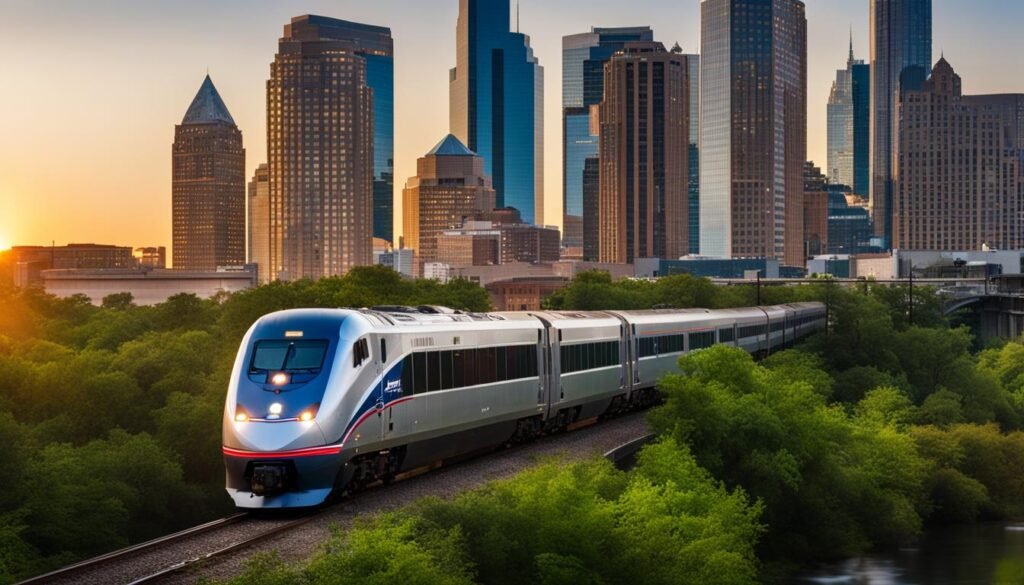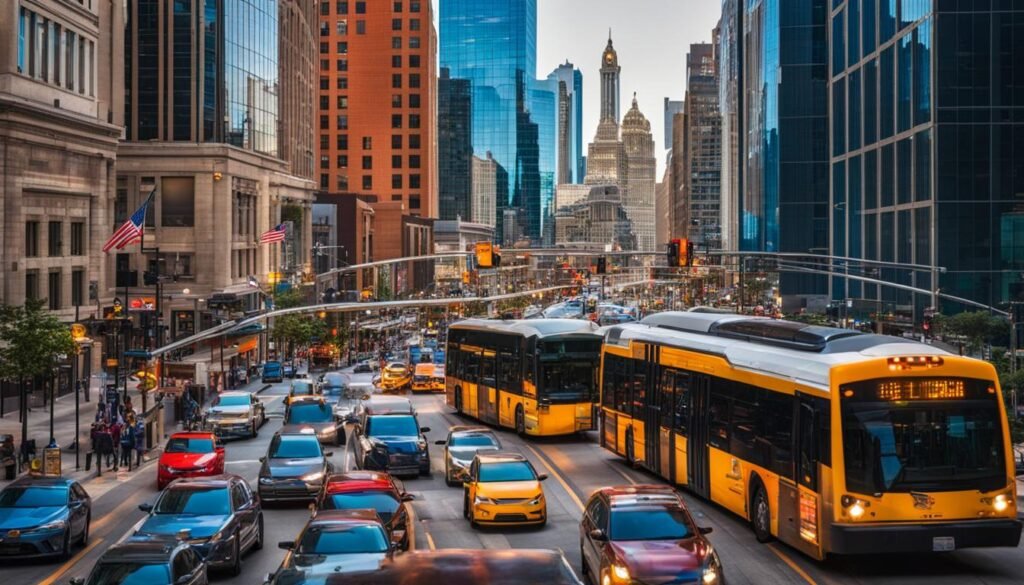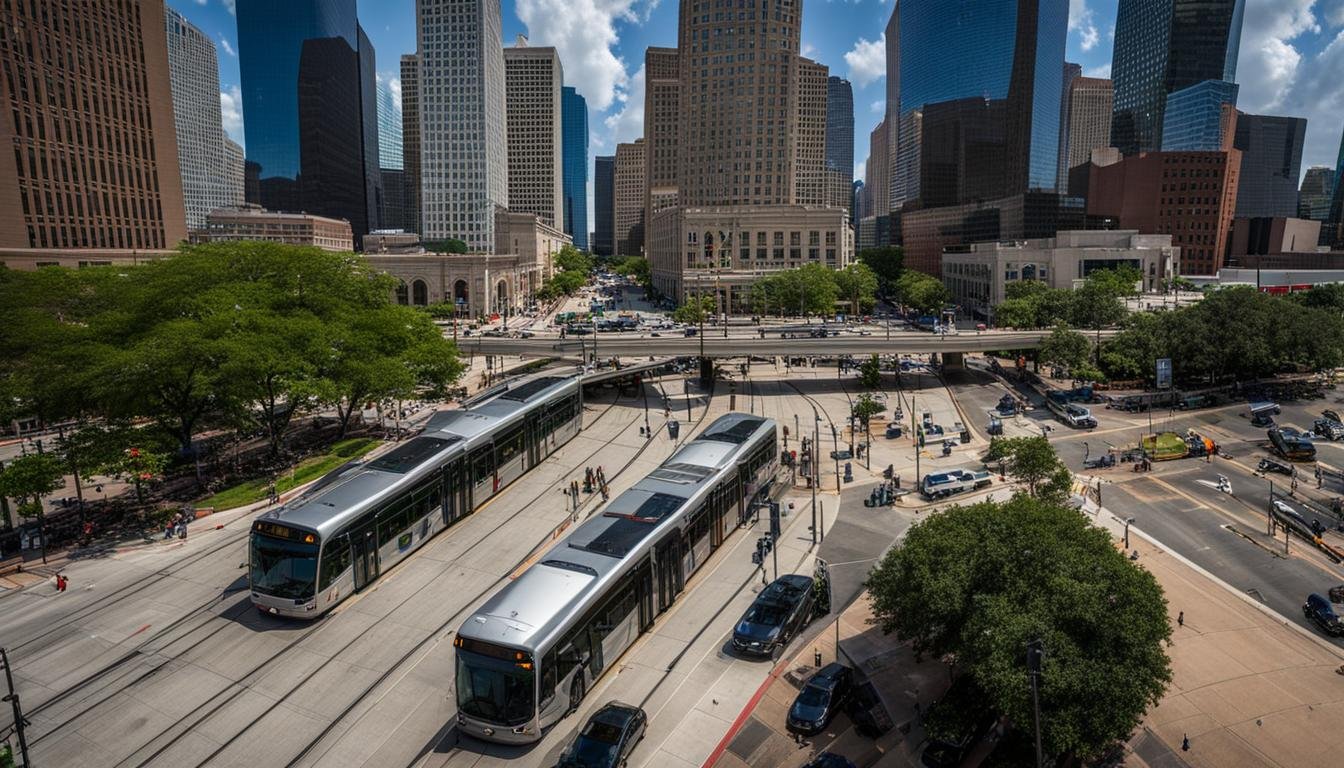Texas is a vast state with a complex transportation network. To navigate public transportation efficiently in major Texas cities, it’s important to understand the various transportation options available. From driving to flying, taking the train or bus, or utilizing public transport within the cities themselves, this guide will provide you with the information you need to navigate Texas’ public transit system.
Key Takeaways:
- Driving is the most common method of travel in Texas.
- Flying is a quick option for long-distance travel within the state.
- Train travel offers a stress-free and scenic alternative.
- Bus travel is a budget-friendly option for those looking to stretch their travel budget.
- Each major city in Texas has its own public transportation system.
Driving as the Primary Method of Travel in Texas
Driving is the most common method of travel in Texas, especially within the major cities. With the vast size of the state, it is often the most convenient and practical option for getting around. Whether you’re exploring the bustling streets of Houston or taking a road trip through the scenic Hill Country, driving provides flexibility and freedom to explore at your own pace.
However, navigating Texas’ highway systems can be a daunting task, especially within busy city centers. It’s important to familiarize yourself with the local traffic rules and be prepared for heavy traffic during peak hours. Planning your routes in advance and utilizing navigation apps can help you navigate the roadways efficiently.
When driving in Texas, it’s also essential to consider gas prices. As of now, gas prices in Texas average around $3.50 per gallon, but they can vary depending on location and market conditions. It’s always a good idea to check gas prices before embarking on a long journey and plan accordingly.
If you’re considering an electric vehicle, Texas boasts a significant number of electric vehicle charging stations. These stations are strategically located throughout the state, making it convenient for electric car owners to charge their vehicles during long drives. Whether you’re driving a traditional gasoline-powered car or an electric vehicle, Texas has you covered.
Popular Road Trips in Texas
Road trips are a popular way to experience the beauty and diversity of Texas. The state offers countless scenic routes, from the iconic Route 66 to the breathtaking landscapes of Hill Country. Here are a few road trips that are worth considering:
- Big Bend National Park: Explore the vast wilderness of West Texas and witness the stunning vistas of Big Bend National Park.
- San Antonio to Austin: Journey from the historic charm of San Antonio, home to the Alamo, to the vibrant music scene of Austin.
- Gulf Coast: Cruise along the Gulf Coast and enjoy the beach towns, fresh seafood, and warm waters.
- Bluebonnet Trail: Take a drive through the Bluebonnet Trail during spring and witness the beauty of wildflowers in full bloom.
Embarking on a road trip allows you to immerse yourself in the rich culture, breathtaking landscapes, and hidden gems that Texas has to offer. So buckle up, hit the road, and create unforgettable memories.
| Gas Prices | Electric Vehicle Charging Stations |
|---|---|
| Average gas prices in Texas: $3.50 per gallon | Texas has a significant number of electric vehicle charging stations |
| Gas prices can vary depending on location and market conditions | Conveniently located throughout the state for long drives |
Flying as a Quick Option for Long-Distance Travel
When it comes to long-distance travel within Texas, flying is a convenient and efficient option. The state boasts several major airports that offer a wide range of domestic flights, connecting you to various destinations across the Lone Star State. Whether you’re planning a business trip or a vacation, flying allows you to reach your destination quickly and comfortably.
Two of the dominant airlines in Texas are American Airlines and Southwest Airlines. Both airlines have established their hubs in Dallas and Houston, providing travelers with extensive flight options. With these airlines’ robust domestic networks, you can easily book flights between major cities in Texas, allowing you to explore the state with ease.
Here are some of the major airports in Texas:
- Dallas/Fort Worth International Airport (DFW) – Located in Dallas, this airport is one of the busiest in the state and offers numerous domestic flights.
- George Bush Intercontinental Airport (IAH) – Situated in Houston, this airport is another major hub that provides a wide range of domestic flight options.
- Austin-Bergstrom International Airport (AUS) – Serving the state capital, this airport offers convenient access to Austin and its surrounding areas.
- San Antonio International Airport (SAT) – Located in San Antonio, this airport connects travelers to various destinations within and outside of Texas.
While flying may not provide the scenic experience of a road trip or train journey, it offers unparalleled speed and convenience, allowing you to spend less time traveling and more time enjoying your destination. Whether you’re visiting family in a different city or exploring Texas for leisure, domestic flights within the state provide a hassle-free option for long-distance travel.
Flying Tips:
- Book your flight in advance to secure the best fares and seat availability.
- Check the baggage allowance and restrictions of your chosen airline.
- Arrive at the airport early to allow time for check-in and security procedures.
- Consider joining the frequent flyer program of your preferred airline to earn rewards and benefits.
- Stay updated on any flight delays or changes through airline notifications or mobile apps.
- Make sure to carry essential travel documents such as a valid ID and your flight itinerary.
Next, let’s explore train travel as an alternative option for stress-free journeys in Texas.
Train Travel for a Stress-Free Journey
While train travel in Texas may not be as popular as driving or flying, it offers a stress-free and scenic alternative to explore the state. Amtrak, the national passenger rail service, operates several routes in Texas, providing travelers with an opportunity to experience the beautiful countryside and admire the scenic views along the way.
Amtrak’s train routes in Texas include:
| Train Route | Departure City | Arrival City |
|---|---|---|
| Heartland Flyer | Oklahoma City, OK | Fort Worth, TX |
| Sunset Limited | New Orleans, LA | Los Angeles, CA |
| Texas Eagle | Chicago, IL | San Antonio, TX |
Please note that train travel can be slower compared to driving or flying, depending on the route and connections available. However, the scenic views and relaxed atmosphere make it a worthwhile option for travelers who appreciate the journey as much as the destination.
Train travel in Texas requires some planning in advance, as the train frequency may vary on certain routes. It’s advisable to check the train schedules and book tickets in advance to secure a seat for your desired travel date.
When considering train travel costs, it’s essential to compare them with the expenses of other transportation options. While train tickets may be more expensive than bus tickets, they can often be more affordable than domestic flights.

Testimonial:
“Traveling by train in Texas was a delightful experience. The scenic views from the train windows were breathtaking, and I had an opportunity to relax and enjoy the journey without any stress. I highly recommend train travel to anyone seeking a unique and leisurely way to explore Texas.”
Affordable Bus Travel for Budget-Friendly Options
When it comes to affordable and convenient transportation in Texas, buses are an excellent option for budget-conscious travelers. Whether you’re exploring major cities, small towns, or remote areas, bus travel provides extensive routes and flexibility to suit your needs.
Two popular bus providers in Texas are Greyhound and Megabus, offering a wide range of bus routes that connect various destinations across the state. These reliable bus services allow you to travel comfortably and affordably, ensuring a stress-free journey.
Greyhound: As one of the oldest and most well-known bus companies in the United States, Greyhound offers a comprehensive network of routes in Texas. Their fleet of modern buses ensures a comfortable ride with amenities such as reclining seats, onboard restrooms, and free Wi-Fi. Greyhound provides an affordable option for travelers looking to explore multiple destinations within Texas.
Megabus: Megabus is another popular bus service that operates in Texas, offering affordable fares and convenient routes. Known for their distinctive blue double-decker buses, Megabus provides a unique travel experience. Passengers can enjoy amenities like power outlets, Wi-Fi access, and comfortable seating, making the journey enjoyable and productive.
While Greyhound and Megabus are great options for budget-friendly travel, there is also a luxury motor coach service called Vonlane for those seeking additional comfort and amenities. Vonlane offers a premium travel experience with features like spacious seating, in-seat power outlets, complimentary Wi-Fi, and onboard food and beverage service.
Bus travel in Texas not only provides an economical option but also allows you to relax and enjoy the scenic views along the way. Whether you’re traveling through bustling cities or picturesque countryside, buses offer a unique perspective of Texas’ diverse landscapes.
When planning your bus travel in Texas, it’s essential to consider ticket prices and availability. Prices may vary depending on the route, time of travel, and demand. It’s advisable to book your tickets in advance to secure your preferred travel dates and times.
Experience the convenience and affordability of bus travel in Texas, exploring the Lone Star State at your own pace. Whether you choose Greyhound, Megabus, or luxury options like Vonlane, you’ll find that bus travel provides a budget-friendly way to discover all that Texas has to offer.
Benefits of Bus Travel in Texas:
- Affordable fares compared to other modes of transportation
- Extensive routes connecting major cities, small towns, and remote areas
- Comfortable seating with amenities like Wi-Fi and power outlets
- Scenic views of Texas’ diverse landscapes
- Flexible schedules and frequent departures
“Bus travel in Texas is not only budget-friendly but also a great way to relax, enjoy the journey, and take in the beautiful scenery.” – Traveler
Public Transportation within Texas’ Cities
Each major city in Texas has its own public transportation system, offering a convenient and affordable option for navigating the urban landscape. Whether you’re exploring the vibrant streets of Austin, the bustling metropolis of Houston, or the historic charm of San Antonio, public transportation can take you where you need to go.
City buses are a common mode of public transportation in Texas cities. With extensive routes and regular schedules, buses provide access to various neighborhoods and destinations throughout the city. Whether you’re commuting to work, visiting popular attractions, or simply exploring the city, hopping on a bus is a convenient way to get around.
Another popular option is the metro rail system, which operates in select Texas cities like Austin, Dallas, and Houston. Metro rails offer a faster and more efficient means of transportation, especially during peak hours when traffic congestion can be a challenge. These rail systems provide quick access to downtown areas, major business districts, and popular entertainment hubs.
Many Texas cities also offer trolley services, adding a touch of nostalgia to your transportation experience. Trolleys are a charming way to explore the city, taking you through historic districts, scenic routes, and popular tourist destinations. They offer a unique perspective and a leisurely way to enjoy your surroundings.
Accessibility and Affordability
Public transportation within Texas cities is generally affordable, offering cost-effective options for residents and visitors alike. Some cities even offer free or discounted fares for specific routes or certain times of the day. This makes public transportation a budget-friendly choice for those looking to save on transportation costs.
Additionally, public transportation in Texas cities strives to be accessible to individuals with disabilities. Buses and metro rails are equipped with features to accommodate wheelchair users, and stations are designed to provide easy access. These efforts ensure that everyone can enjoy the benefits of public transportation and travel with ease.
However, it’s important to note that public transportation may not be as extensive or efficient as in other cities across the US. Depending on your destination and schedule, using public transportation may require additional time and effort compared to driving a car. Nonetheless, it remains a viable and sustainable option for getting around Texas cities.

“Using public transportation in Texas cities allows you to experience the local culture, engage with the community, and avoid the hassle of parking and traffic. It’s a convenient and eco-friendly way to navigate the city.”
Accessible Transportation Options
Travelers with mobility issues can find accessible transportation services throughout Texas, including airports, trains, and buses. Major rental car companies offer adaptive devices at no extra charge, and many cities have accessible local transportation services like buses and metro lines. However, accessibility options may be more limited in smaller towns and cities. It’s important to plan ahead and research the availability of accessible transportation options when traveling in Texas.
Public Transit Funding and Challenges
Texas’ public transit systems rely on a combination of funding sources from the federal, state, and local levels. The Texas Department of Transportation (TxDOT) plays a crucial role in providing funding to both urban and rural transit districts, ensuring that public transportation remains accessible across the state.
Metropolitan transit authorities (MTAs) in Texas primarily rely on local sales taxes as a major revenue source to support their operations. These taxes are essential for maintaining and expanding public transit services within metropolitan areas, catering to the diverse transportation needs of residents and visitors alike.
However, public transit agencies in Texas face significant challenges, including declining ridership and rising operating expenses. The COVID-19 pandemic has further exacerbated these difficulties, as travel restrictions and safety concerns have contributed to reduced public transit usage.
As a result, transit agencies must navigate these challenges and seek innovative solutions to sustain and enhance their services. In order to secure the future of public transit in Texas, various factors will play a crucial role, including population growth, funding allocations, and adaptability to changing transportation needs.
By addressing these challenges head-on, public transit systems in Texas can continue to provide efficient, affordable, and sustainable transportation options for the public, contributing to improved mobility and reduced congestion on the roads.
Conclusion
Navigating public transportation in major Texas cities offers travelers a range of transportation options for efficiently getting around. While driving is the most common method of travel in Texas, it’s important to consider other alternatives such as flying, train travel, and bus travel. These options not only provide convenience and affordability but also offer unique travel experiences.
Within Texas’ cities, public transportation systems play a key role in providing accessible and cost-effective options. Buses and metro rails connect various neighborhoods and destinations, offering an alternative to driving. While public transportation may require additional time and effort, it remains a viable mobility option for both residents and visitors.
Despite challenges faced by transit agencies, public transit continues to be an important component of Texas’ transportation network. Understanding the various transportation options available and planning travel in Texas will enhance the overall experience and help travelers explore the beauty and diversity of the state.








